- Unmatched Sailing Experience: Croatia offers a unique mix of over 1,200 islands, pristine turquoise waters, and historic coastal towns. Every port and bay tells a story, from ancient Roman ruins to medieval fortresses.
- Optimal Sailing Seasons: The best times to explore Croatian waters are during the shoulder months of May and September, offering moderate temperatures and less crowded marinas. Peak season (June through August) provides warm weather and vibrant coastal festivities, though with higher prices and more tourists.
- Diverse Yacht Charter Options: Whether you opt for a classic sailing yacht, a stable catamaran, or a luxurious motor yacht, there is a vessel to match every skill level and group size. Essential tips include understanding licensing requirements, local navigation rules, and preparing a comprehensive packing checklist.
KEY TAKEAWAYS
Introduction
Croatia is one of Europe’s most sought-after sailing destinations, boasting over 1,200 islands, islets, and reefs scattered across a crystal-clear Adriatic Sea. From ancient Roman ruins to medieval fortresses perched above charming harbors, every part of the Dalmatian coastline tells a story. Stretching over 1,700 kilometers, Croatia’s shoreline offers an incomparable blend of Mediterranean charm and Slavic tradition, calling to adventurers and leisure travelers alike.
This Yacht Charter in Croatia Guide is your complete planning companion to experiencing this Adriatic gem by sea. Whether you’re dreaming of anchoring in secluded bays, exploring UNESCO-listed towns like Dubrovnik and Split, or discovering hidden coves on remote islands, this Croatia sailing guide equips you with everything you need.
Within this detailed yacht charter Croatia guide, you’ll find practical advice on when to sail, must-see islands like Hvar and Vis, yacht types suited to your needs, and essential navigation and safety tips. It also covers customs, marinas, permits, and the best sailing routes.
With its rich history, mild Mediterranean climate, and world-renowned island culture, Croatia promises a sailing experience like no other. Use this guide to unlock the full potential of your maritime adventure.
Why Choose Croatia for a Yacht Charter
Croatia offers one of the most enchanting sailing experiences in the world, with a rich blend of natural wonders, cultural heritage, and ideal nautical conditions. A yacht charter in Croatia opens doors to 1,244 islands and islets scattered along the pristine Adriatic coastline, forming one of the most indented shorelines in Europe. This island-dense region includes untouched gems like Šolta, Lastovo, and Vis, perfect for anchoring away from crowded ports.
The crystal-clear turquoise waters surrounding Croatia’s coastline are renowned for their visibility and calm seas, making them ideal for sailors of all experience levels. Hidden coves, blue caves, and pebbled beaches make each nautical mile visually rewarding. National parks such as Kornati—a sailor’s maze of 89 islands—and Mljet, with its saltwater lakes and dense forests, offer serene anchorages set in protected areas. These parks are managed under strict conservation laws and require permits, ensuring the preservation of Croatia’s natural beauty.
Beyond nature, Croatia boasts a layered history shaped by Illyrians, Romans, Venetians, and Austro-Hungarians. A sailing itinerary through Dalmatia or Istria unveils medieval walled cities, Roman ruins, Renaissance palaces, and Gothic cathedrals. Dubrovnik’s Old Town, a UNESCO World Heritage Site, showcases Baroque churches and ancient fortresses. Split’s Diocletian’s Palace, a 4th-century Roman structure interwoven with busy alleyways, is a living museum. Hvar Town combines Venetian architecture with lively piazzas and Mediterranean flair (Source).
Local life along the coast pulses with festivals, open-air concerts, and a celebrated culinary scene. Traditional Dalmatian dishes—like black cuttlefish risotto, peka-roasted lamb, and fresh octopus salad—reflect centuries of Mediterranean and Slavic fusion. Paired with local wines such as Plavac Mali, each meal becomes a cultural immersion.
The Mediterranean climate, defined by warm summers and mild winters, makes Croatia a reliable sailing destination. The sailing season spans April to October, peaking from June through August. Warm sea temperatures and steady Maestral winds dominate the high season, offering smooth cruising. The shoulder seasons of May and September are quieter, ideal for more relaxed sailing with moderate temperatures and uncrowded harbors. According to the Croatian Meteorological and Hydrological Service, average summer sea temperatures range from 23 to 27°C, while daylight extends past 14 hours—perfect for long exploratory days.
A Croatia sailing guide isn’t complete without recognizing the seamless marina infrastructure. Over 60 marinas, many operated by ACI (Adriatic Croatia International Club), offer modern amenities, fuel stations, and provisioning services. Whether you dock in bustling cities like Trogir or remote bays near Šibenik, convenience and safety are never far.
From timeless stone cities to sapphire lagoons between unspoiled islands, a yacht charter Croatia voyage offers the ultimate balance of culture, nature, and sea-borne adventure.
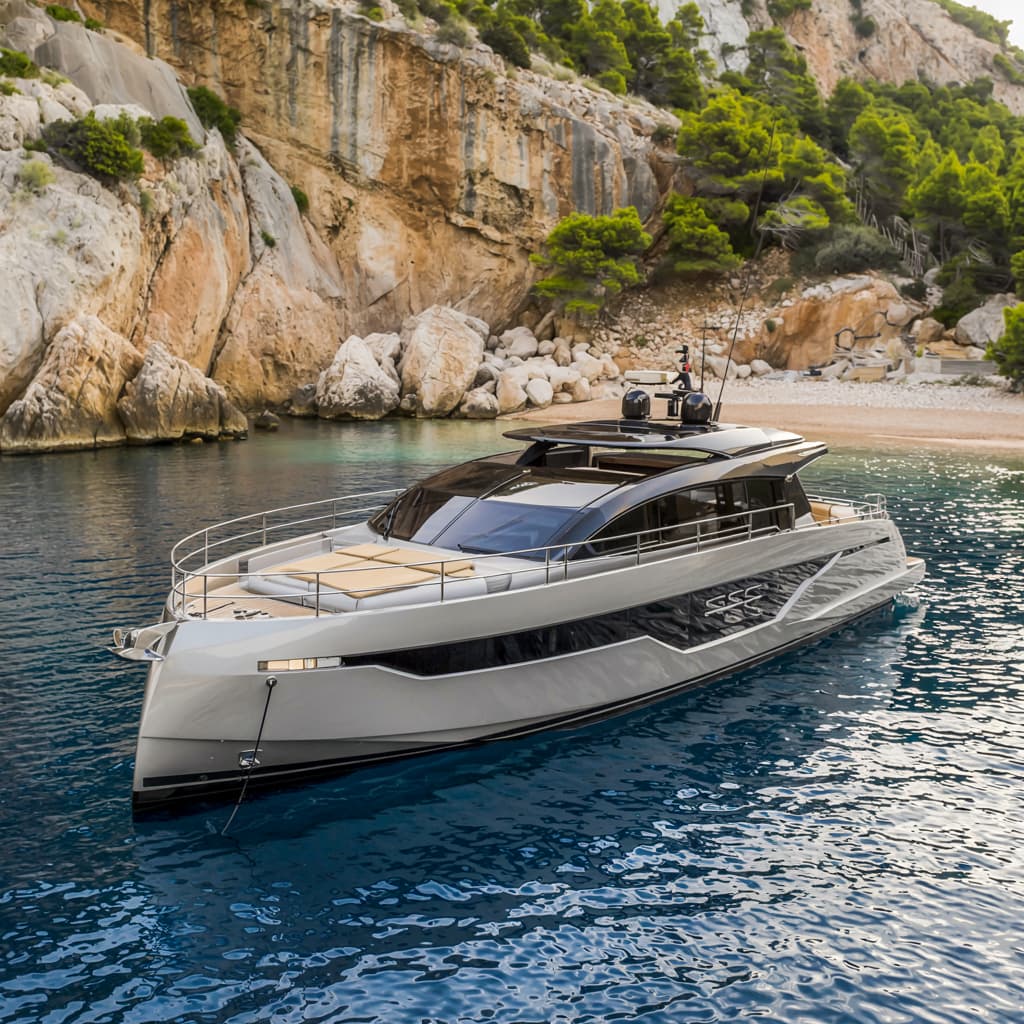
Best Time to Sail in Croatia
Croatia’s sailing season spans April to October, but each month offers unique conditions for yacht charters. Understanding seasonal patterns is vital when navigating this breathtaking Adriatic playground.
Peak season runs from June to August, with sunny weather, temperatures between 25–30°C, and moderate winds—often ideal for less experienced sailors. Coastal towns like Hvar and Split buzz with events, nightlife, and full marinas. However, expect larger tourist crowds and higher charter prices.
Shoulder seasons—May and September—are generally regarded as the optimal sailing months. Daytime temperatures range from 20–25°C, winds are steady yet manageable, and the sea remains warm enough for swimming. Marinas and anchorages are less congested, and sailing conditions are still ideal for most experience levels. Additionally, charter rates drop up to 25% compared to peak months.
In April and October, weather becomes less predictable. Temperatures drop to 16–21°C, and sudden storms can occur, especially in the north. These months suit seasoned sailors seeking solitude, lower prices, and uncrowded bays.
For a well-balanced Croatia sailing guide experience with excellent weather, availability, and manageable crowds, sail in May, early June, or mid-September. Monitor marine forecasts via the Croatian Meteorological and Hydrological Service to stay informed.
Top Sailing Destinations
Croatia’s Adriatic coastline is a sailor’s paradise, offering dramatic landscapes, historic cities, and over 1,000 islands. This Croatia sailing guide explores the most iconic destinations, starting with the Dalmatian coast and stretching to its national parks.
See Croatia yacht charter options.
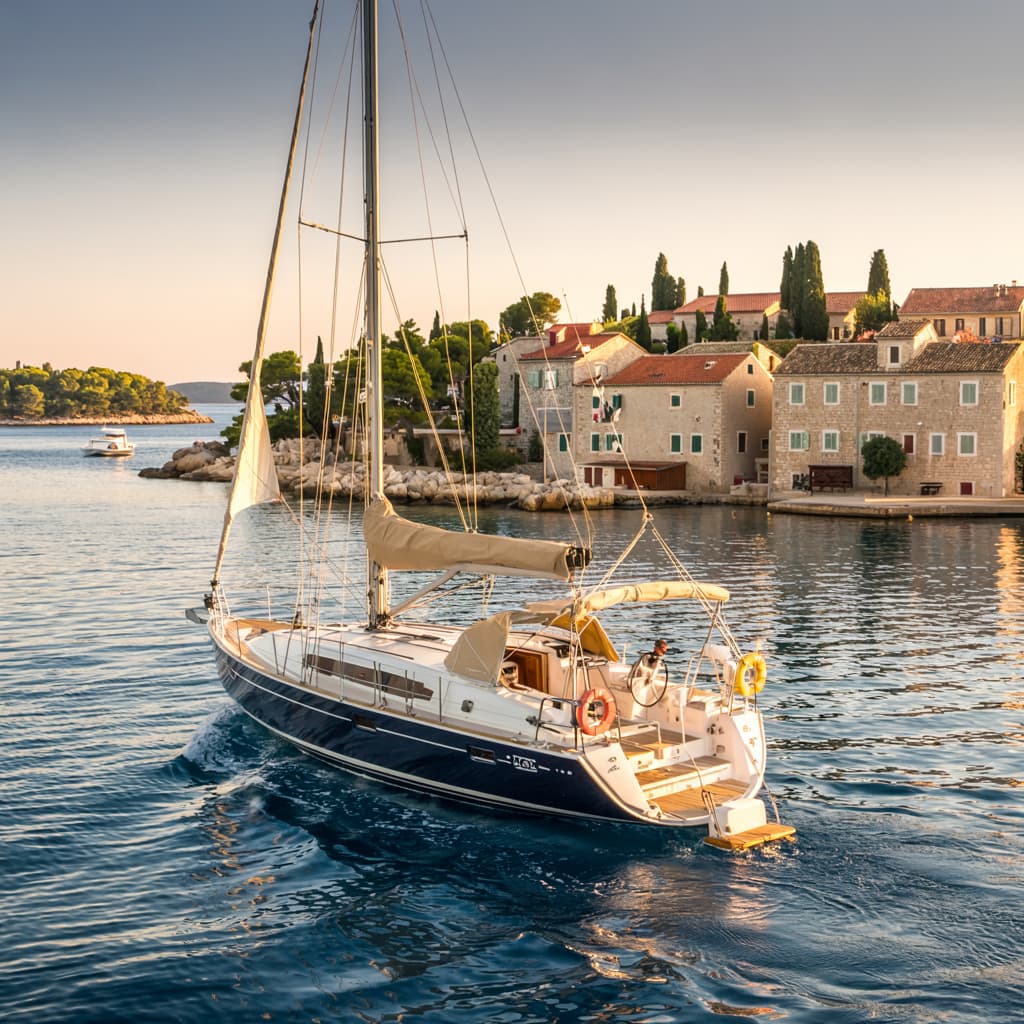
Split – Gateway to the Islands
Split is one of the largest coastal cities and a popular embarkation point for yacht charters. Its 1,700-year-old Diocletian’s Palace, a UNESCO World Heritage Site, is built into the city’s core. Nearby, the Riva promenade buzzes with bars and restaurants, offering lively vistas of the marina. Marinas like ACI Marina Split and Marina Kaštela provide direct access to the southern islands.
Dubrovnik – The Pearl of the Adriatic
Dubrovnik is surrounded by massive stone walls built in the 16th century. Its Old Town features Gothic, Renaissance, and Baroque architecture. Sail into the old port and explore the Rector’s Palace or climb the city walls for sweeping views. Thanks to its popularity, Dubrovnik is best visited in shoulder seasons to avoid peak tourist crowds.
Hvar – The Queen of the Islands
Known for upscale nightlife, historic fortresses, and lavender fields, Hvar is a staple in every Croatia sailing guide. Anchoring near the Pakleni Islands lets you explore clear lagoons and escape the harbor’s busy moorings. St. Stephen’s Cathedral and the 16th-century Hvar Fortress offer rich cultural stops in town.
Korčula – Little Dubrovnik
Korčula is famed for its medieval grid layout and fortified walls. Often linked with Marco Polo, who was allegedly born here, the island is perfect for sailing historians. The vineyards of Lumbarda and pine-covered beaches offer a contrast to its storied old town.
Vis – Untouched Beauty and Seclusion
Vis was closed to foreigners until 1989 due to its military use, preserving its authenticity. It hosts the Blue Cave on nearby Biševo Island—accessible only by small boats—which glows with ethereal light between 11 AM and 1 PM. Komiža and Vis Town are tranquil mooring options with traditional konobas (taverns) and pebble beaches.
Brač – Home to Zlatni Rat
Brač features the famed Zlatni Rat Beach, a shifting horn-shaped spit near Bol, ideal for windsurfing. Island explorations reveal sleepy inland villages like Škrip, Croatia’s oldest settlement, along with olive groves and stone quarries that built Diocletian’s Palace.
Explore more about top sailing destinations Croatia guide.
Kornati and Brijuni National Parks – Untamed Natural Wonders
The Kornati Archipelago contains 89 rocky islets and reefs, ideal for sailing and diving. These uninhabited islands offer secluded moorings and are protected as a national park. Visit the official site here: Kornati National Park.
Farther north, Brijuni National Park combines nature and archaeology. Once Tito’s private retreat, it has Roman ruins, a safari park, and tranquil anchorages. The official source is available here: Brijuni National Park.
Each of these destinations contributes to why Croatia is one of the top global sailing playgrounds. Whether seeking historical depth, scenic isolation, or island-hopping adventure, this Croatia sailing guide provides the perfect blueprint.
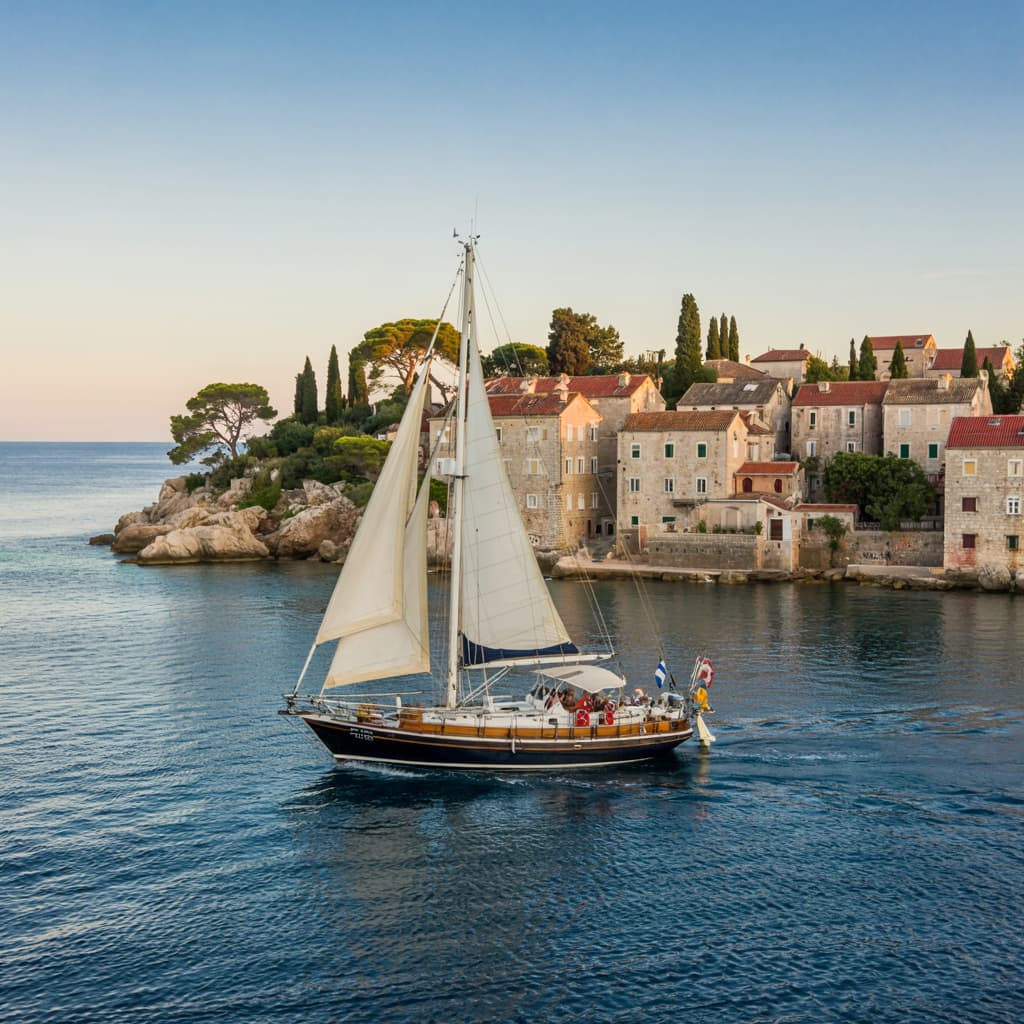
Sailing Routes and Itineraries
A popular week-long Croatia sailing itinerary begins in Split, the country’s sailing hub. From the ACI Marina Split, head to Šolta, a tranquil island dotted with olive groves. Next, sail to Hvar to explore the 16th-century fortress and vibrant nightlife in Hvar Town.
Continue toward Vis, once a Yugoslav military base and now a peaceful retreat known for its untouched nature. Don’t miss Biševo Island, home to the famous Blue Cave. Visit around midday to see the cave’s ethereal blue glow reflected on the water. Then cruise to Korčula, a walled city claiming to be Marco Polo’s birthplace. Stroll its medieval streets and sample local Grk wine from Lumbarda vineyards.
Next, sail to Bol on Brač Island to see Zlatni Rat, one of Europe’s most photographed beaches. End your loop via Milna or Maslinica before returning to Split.
For weekend trips, a relaxing route includes visits to Trogir, a UNESCO World Heritage Site featuring Romanesque and Renaissance architecture, and Drvenik Veli, ideal for quiet anchorages.
Adventurous sailors can head north to the Istrian Peninsula or explore the 300-island Zadar Archipelago. Always adapt your itinerary to your sailing level, and check marine weather forecasts using official nautical charts and local guides to ensure a safe and rewarding journey.
Yacht Charter Options in Croatia
Sailing Yachts: The Classic Mediterranean Experience
Sailing yachts are among the most popular vessel types for a yacht charter Croatia adventure. These monohull boats offer a traditional sailing experience, allowing you to harness the power of the wind as you explore the Dalmatian Coast. Known for high maneuverability and fuel efficiency, they are ideal for skilled sailors looking for a genuine maritime challenge. They typically range from 30 to 60 feet and feature 2 to 5 cabins, suitable for smaller groups or couples. For routes involving longer passages or variable winds—like around the Kornati Islands—a modern sailing yacht with strong upwind performance is a smart choice.
See Croatia sailboat charter options.
Catamarans: Spacious and Stable
Catamarans are widely favored in yacht charter Croatia options, especially for families or larger groups. With twin hulls, they offer superior stability, drastically reducing seasickness—a common concern for newcomers. Their broad beam provides ample deck space, larger lounging areas, and often an open-concept saloon-kitchen layout with panoramic views. Vessels like the Lagoon 42 or Bali 4.6 offer 4 to 6 cabins with private heads. Due to their shallow draft, catamarans allow anchoring access in secluded coves like those around Mljet and Lastovo National Parks. They are especially popular for relaxed island-hopping experiences.
See Croatia catamaran charter options.
Motor Yachts: Speed and Luxury Combined
Motor yachts grant the speed required to cover more distance, such as Split to Dubrovnik in a single day. They are excellent for guests prioritizing time, comfort, and premium onboard amenities. With greater horsepower comes increased fuel consumption, so budgeting for fuel is key. These yachts, often fitted with high-end features like jacuzzis, air conditioning, and onboard chefs, appeal to those seeking a luxury yacht experience. Models like the Princess V-class or Sunseeker series represent top-tier choices among Croatia’s charter fleets.
See Croatia motor yacht charter options.
Gulets: Traditional Elegance with Modern Comfort
Gulets, originally used for fishing and transport in Turkey and Croatia, now serve as luxurious charter vessels offering wooden elegance and nostalgic charm. These 20-30 meter sailing yachts typically include spacious cabins with ensuite bathrooms, large dining areas, and dedicated crews including a captain, cook, and deckhands. Gulet charters are fully crewed and ideal for cultural exploration, such as visiting old ports like Ston and Korčula. Full-board options are often available, making gulets suitable for leisurely cruising through Croatia’s calmer regions.
See Croatia gulet charter options.
How to Choose the Right Yacht
When selecting a vessel, consider your group size, cabin needs, preferred sailing style, and budget. A bareboat yacht charter in Croatia suits experienced sailors with required certifications. For a relaxed escape, crewed or skippered options provide local insights and handle all navigational responsibilities.
Always verify each charter company’s credentials. Choose providers with positive client reviews, transparent pricing, and well-maintained fleets. Reputable charter firms should be members of trusted organizations such as the Croatian Chamber of Economy – Nautical Sector. This ensures compliance with safety standards and fleet inspections.
Prioritize charter services that disclose full costs upfront, including cleaning fees, mooring charges, and possible security deposits. Reliable providers also list their provisioning services and optional extras like paddleboards or Wi-Fi systems.
Exploring yacht charter Croatia options is not just about picking a boat—it’s about finding the right maritime lifestyle that complements your travel goals and comfort expectations.
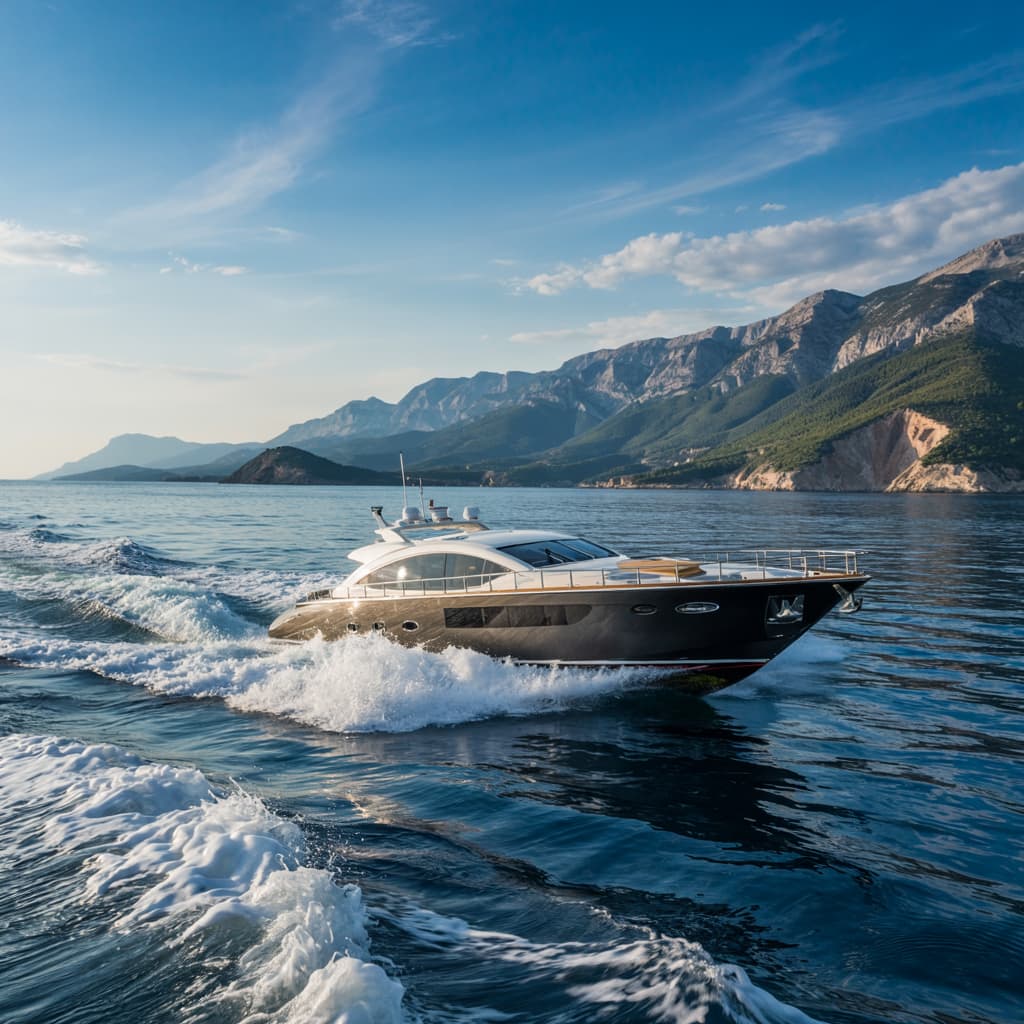
Croatia Yachting Tips
Licensing and Maritime Rules
For bareboat yacht charters in Croatia, the skipper must present a valid International Certificate of Competence (ICC) or a national equivalent approved by Croatian authorities. Recognized alternatives include RYA Day Skipper or ASA 104 certifications. Additionally, a VHF (Short Range Certificate) radio license is mandatory to operate marine communication equipment, as per the rules of the Ministry of the Sea, Transport and Infrastructure. You can verify accepted licenses on the official list published by the Croatian ministry (Source).
If you lack the qualifications, hiring a local skipper is an excellent choice. Croatian skippers are not only licensed navigators but also know the Adriatic’s secret coves, current patterns, and port regulations. Local professionals often speak English and handle VHF communications and docking with ease—enhancing both safety and your enjoyment.
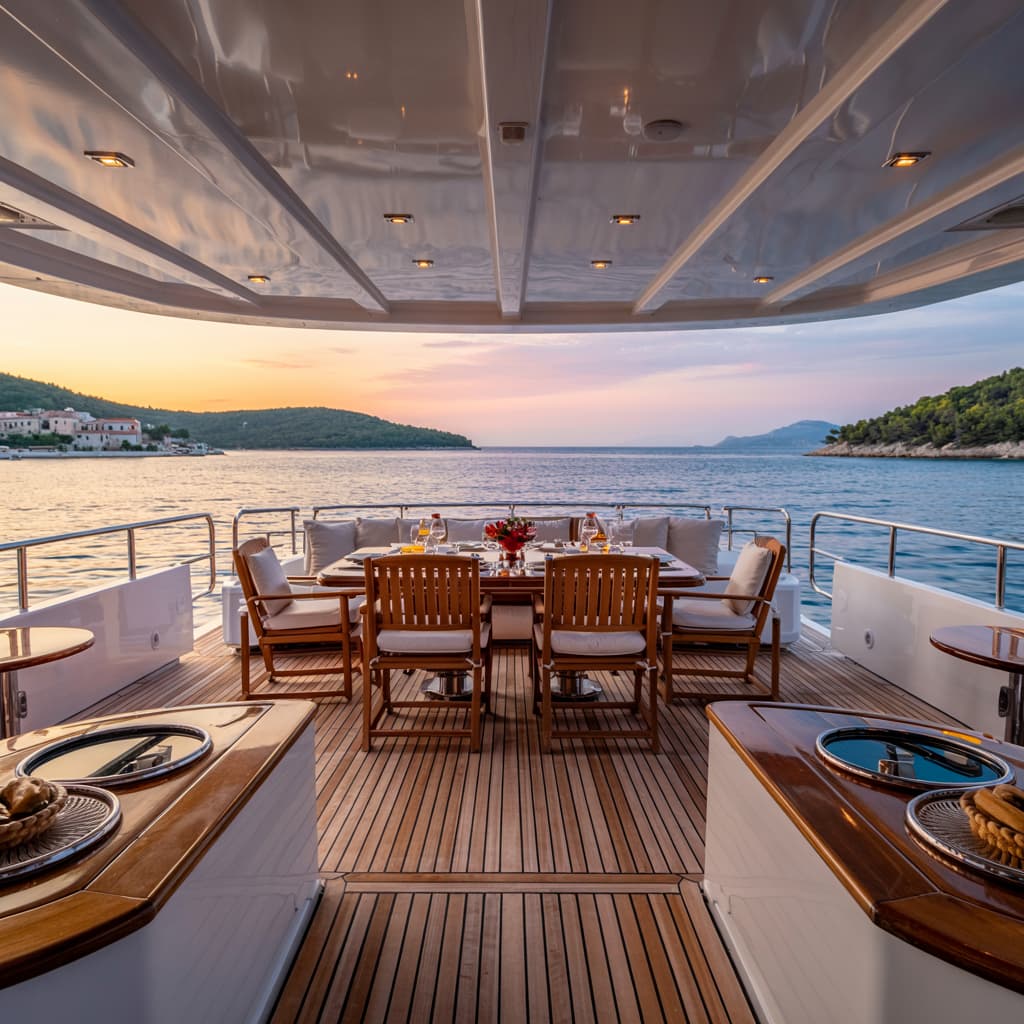
Packing Checklist for Smooth Sailing
Packing smart can make or break your yachting experience. Essentials include light, breathable clothing for hot Mediterranean days and a windbreaker for cooler evenings. Non-slip, light-soled shoes are vital for onboard safety and deck protection.
Bring strong sun protection: reef-safe sunscreen, wide-brimmed hats, polarized sunglasses, and UV-resistant swimwear. Don’t overlook personal hygiene products (biodegradable where possible), seasickness remedies, and a waterproof dry bag for electronics.
For provisions, stock up on fresh water, snacks, easy-to-cook meals, and local produce from island markets. Entertainment items like books, snorkeling gear, cards, and a downloaded music playlist are great for downtime.
Local Etiquette and Cultural Awareness
Croatians are hospitable, and showing respect to their customs boosts your welcome. Use basic phrases like “Dobar dan” (Good day), “Hvala” (Thank you), and “Molim” (Please). English is widely spoken in marinas and seaside towns, but even a few Croatian words show thoughtfulness.
In conservative coastal villages, modest attire—especially in churches or traditional restaurants—is appreciated. Topless sunbathing is limited to designated beaches.
Always dispose of trash responsibly. Use recycling bins at marinas and avoid discharging waste near sensitive marine zones. Moor using designated buoys rather than anchoring over seagrass, protecting fragile underwater ecosystems.
Safety and Navigation Tips
Safety begins with regular weather checks. Use real-time updates from official Croatian maritime sources or local VHF broadcasts. Be alert to sudden shifts caused by the Bura (a dry, northeasterly wind) or Jugo (a humid southern wind).
Carry and know how to use navigational tools like GPS plotters, paper charts, and tracking apps like Navily or Navionics. Always file a float plan with the charter base and inform them of changes to your route. In an emergency, call the National Maritime Rescue Coordination Centre (MRCC Rijeka) on Channel 16.
Following these Croatia yachting tips will ensure a seamless and respectful sailing journey along one of Europe’s most captivating coastlines.
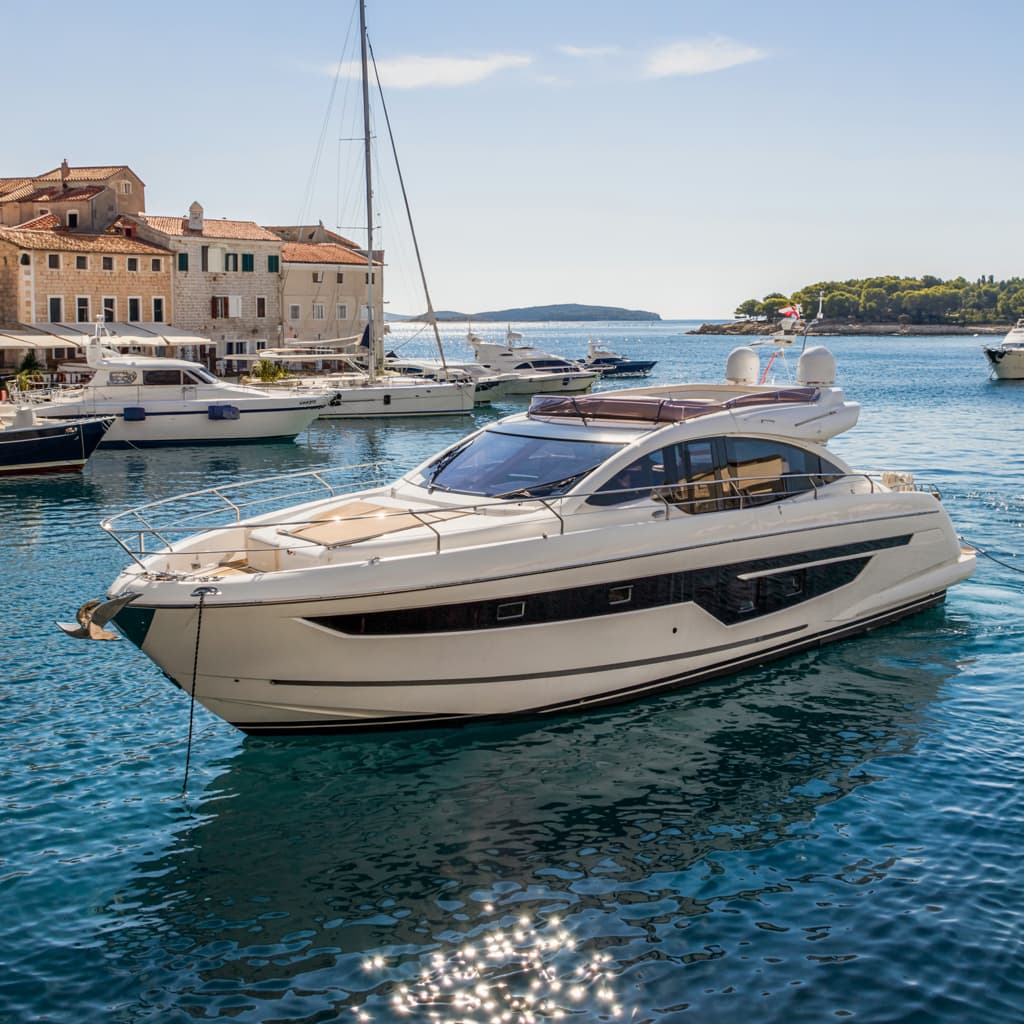
Practical Information
Accepted Licenses and Documentation
Before booking a yacht charter in Croatia, ensure that your skipper’s license is recognized by Croatian authorities. The most commonly accepted licenses include the International Certificate of Competence (ICC), RYA Day Skipper, ASA 104 Bareboat Cruising, and similar national equivalents. In addition, a valid VHF (SRC) radio license is mandatory for operating the boat and communicating with marinas and harbor authorities.
Not all licenses are accepted by every charter company, so always confirm with your yacht rental provider in advance. The Ministry of the Sea, Transport and Infrastructure maintains an updated list of accepted licenses.
Language and Useful Croatian Terms
English is spoken widely in Croatia’s coastal regions, especially in marinas, restaurants, and tourist facilities. Local harbor masters and marina staff are generally proficient in English. However, knowing a few Croatian sailing terms can enhance your experience and help build rapport with locals:
– “Luka” – Port
– “Sidro” – Anchor
– “More” – Sea
– “Bova” – Buoy
– “Vjetar” – Wind
These simple terms help when reading nautical charts or discussing mooring logistics.
Charter Costs and Budgeting
Costs for a yacht charter Croatia holiday vary depending on the season, boat size, and crew services. A bareboat charter typically starts from €1,000–€3,500 per week for a sailing yacht (30–45 ft) during shoulder season. In peak summer, prices can rise to €5,000 or more. Crewed charters, which include a skipper and possibly a hostess or chef, usually range from €6,000 to over €20,000 per week for luxury options.
Additional expenses include fuel (typically €100–€400 per week), mooring fees (ranging from €50–€150 per night depending on marina), provisions, national park entry fees, and gratuities. Tipping the crew is customary—5–15% of the charter fee depending on service quality.
Set aside a contingency fund of at least 10% of your total budget for unplanned costs like emergency marina stops or equipment rental. Using provisioning services in advance can help reduce last-minute expenses.
Weather, Wind Patterns and Safety
Understanding Croatian weather is essential for safe sailing. The Adriatic Sea is generally calm, but sailors must be aware of regional wind patterns:
– Maestral: A pleasant afternoon northwesterly wind, ideal for sailing. Most common in summer.
– Bura: A strong, dry northeasterly wind. Can occur suddenly and create dangerous conditions near the coast.
– Jugo: A humid southeasterly wind bringing clouds and rain. Often signals low-pressure systems.
Always monitor forecasts using the Croatian Meteorological and Hydrological Service. Adjust your route daily to avoid headwinds and strong gusts, especially around channels like the Velebit or Pelješac regions, where Bura is most forceful.
For the safest yacht experience, plan harbor stops accordingly and avoid open sailing during adverse conditions. Mariners are advised to wake early to catch calmer morning seas when planning longer passages.
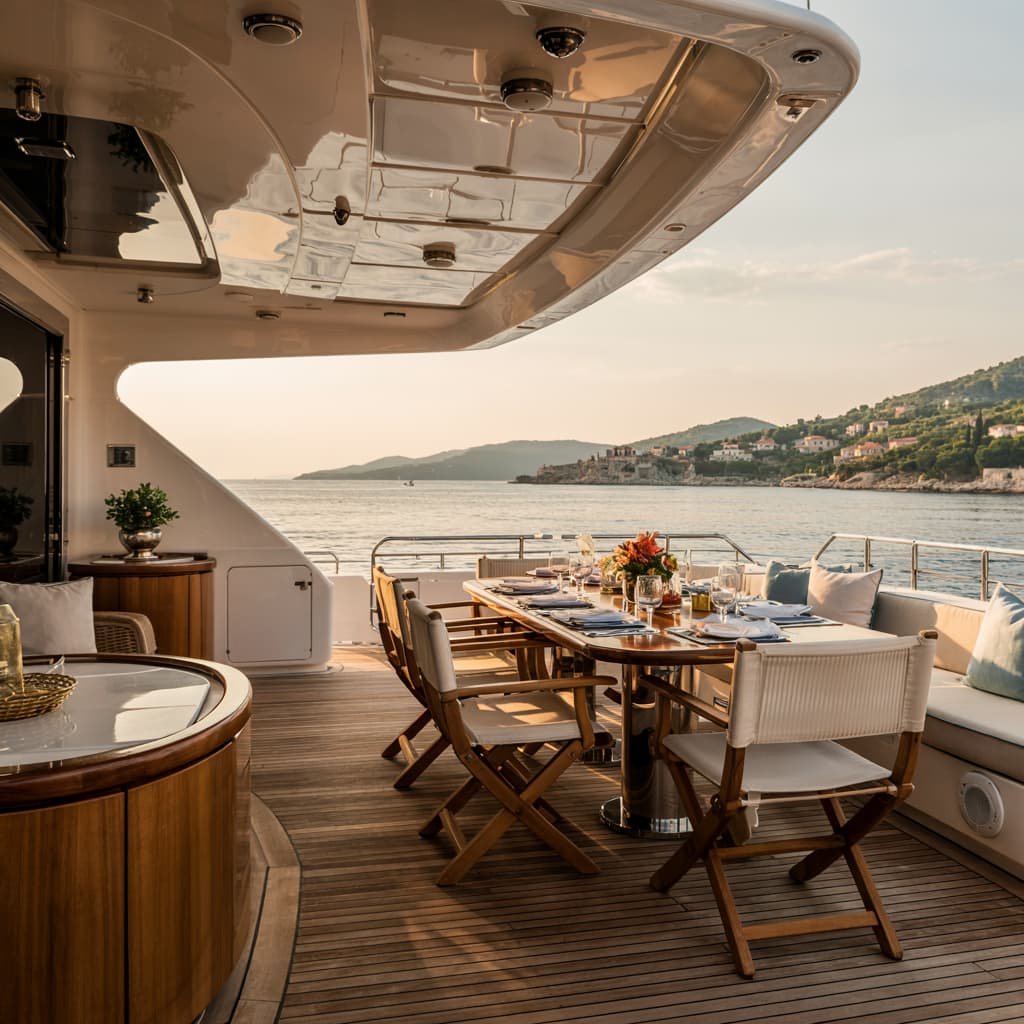
Conclusion
Chartering a yacht in Croatia offers an unmatched blend of natural beauty, historical charm, and ideal sailing conditions. With more than 1,200 islands along its radiant Adriatic coast, Croatia delivers an extraordinary island-hopping experience, from the ancient port city of Split to the Renaissance allure of Dubrovnik. Every bay, beach, and coastal village tells a story, shaped by centuries of Venetian, Roman, and Slavic heritage.
This Yacht Charter in Croatia Guide provides all you need to plan a seamless adventure—from choosing between bareboat and crewed charters to forming safe routes around the ever-changing winds like the Maestral and Bura. Our tips span legal requirements, budgeting, cultural insights, and personalized sailing itineraries.
Croatia’s well-developed marina infrastructure, with over 50 marinas certified by the Croatian Ministry of Tourism, ensures convenience and safety. Whether you seek vibrant nightlife on Hvar, tranquil bays in the Kornati archipelago, or historical exploration on Brač and Korčula, a yacht charter Croatia holiday provides the freedom to design your perfect journey.
Contact trusted charter providers, book early, and begin crafting your sailing adventure. Let this guide anchor your planning and help you discover why Croatia remains the crown jewel of Mediterranean yachting. The Adriatic is calling—are you ready to set sail?
Additional Resources
For comprehensive Croatia yachting tips, consult official nautical charts from the Croatian Hydrographic Institute, which publishes updated maritime maps, pilot books, and tide tables critical for safe navigation. Source
The Croatian National Tourist Board provides useful travel advisories, seasonal sailing insights, marina infrastructure details, and port location guides. Source
For regulations on vessel registration, customs procedures, and maritime safety rules, refer to the Ministry of the Sea, Transport and Infrastructure. Always verify entry policies, VHF channel protocols, and anchoring rules. Source
These sources are vital for planning a legal, safe, and seamless sailing experience along Croatia’s Adriatic coastline.
| Category | Details |
| Destination | Croatia – Explore over 1,200 islands, islets, and reefs in the crystal-clear Adriatic Sea. |
| Best Time to Sail | April to October; peak season in June–August; shoulder seasons in May and September for quieter anchorages and moderate temperatures. |
| Types of Charters | – Bareboat Charters – Crewed/Skippered Charters – Options include Sailing Yachts, Catamarans, Motor Yachts, and Gulets |
| Key Ports & Marinas | Split, Dubrovnik, Trogir and over 60 certified marinas (many operated by ACI) offering modern facilities. |
| Popular Destinations | – Dubrovnik’s Old Town & ancient fortresses – Split’s Diocletian’s Palace – Hvar, Vis (Blue Cave), Korčula, Brač (Zlatni Rat), and national parks like Kornati and Brijuni |
| Sailing Routes & Itineraries | Week-long loops from Split visiting Šolta, Hvar, Vis, Korčula and Brač; weekend trips to Trogir and Drvenik Veli; alternative routes in Istria and Zadar Archipelago. |
| Licensing & Regulations | Valid skipper’s license (ICC, RYA Day Skipper, ASA 104, or national equivalent) and a VHF (SRC) radio license are required. |
| Budget & Costs | Bareboat charters from €1,000–€3,500 per week in shoulder season; crewed charters may range from €6,000 to over €20,000 per week. Additional costs include fuel, mooring fees, provisions, and tips. |
| Weather & Climate | Mild Mediterranean climate with warm summer sea temperatures (23–27°C) and prevailing Maestral winds; be mindful of sudden winds like Bura and Jugo. |
| Cultural & Culinary Highlights | A blend of Venetian, Roman, and Slavic heritage; experience traditional Dalmatian cuisine featuring black cuttlefish risotto, peka-roasted lamb, fresh seafood and local wines such as Plavac Mali. |
| Safety & Navigation Tips | Monitor official weather updates and marine forecasts; use navigational tools (GPS, charts, apps); file a float plan and adhere to local maritime rules. |
| Useful Resources | – Croatian Meteorological and Hydrological Service – Croatian Hydrographic Institute – Ministry of the Sea, Transport and Infrastructure |
FAQs
Croatia is a top choice for yacht charters due to its 1,200 islands and pristine Adriatic coastline. The country’s blend of natural beauty, cultural heritage, and reliable nautical conditions, including calm seas and scenic coves, offers a unique sailing experience.
The optimal time to charter a yacht in Croatia is during the shoulder seasons of May and September. The temperatures range from 20–25°C, conditions are ideal for sailing, and tourists are fewer, reducing congestion at marinas.
In Croatia, popular yacht charter options include sailing yachts for a traditional experience, catamarans for spacious comfort, motor yachts for speed and luxury, and gulets for historical charm. Each type suits different group sizes, preferences, and budgets.
Key areas to explore include Split, known as the gateway to islands; Dubrovnik for its historical majesty; Hvar for upscale nightlife; Korčula, Vis, and Brač for their untouched beauty; and national parks like Kornati and Brijuni for natural marvels.
For a bareboat yacht charter, the skipper needs an ICC or equivalent, and a VHF radio license. These are crucial for sailing solo, ensuring compliance with maritime regulations and safe operation of marine communication equipment.
Charter costs vary based on season, boat size, and whether the charter is bareboat or crewed. Prices can start from €1,000–€3,500 per week for a sailing yacht during shoulder seasons, reaching €6,000 or more in peak months or for luxury options.
Safety involves checking weather forecasts for winds like Maestral, Bura, and Jugo which affect sailing conditions. Planning routes carefully, especially in areas prone to sudden weather changes, and monitoring real-time updates are essential for a safe journey.

